Nurses communication with alzheimer patients in the care setting
Introduction
The language impairment in patients with Alzheimer’s disease in care setting has become an issue for the nurses because increased number of similar patients are required to be attended by them who have speech problems.
Aim: The aim of the
study is to determine the ways used by nurses are to use to overcome barriers in interaction and establish enhanced communication to deliver appropriate care to the Alzheimer’s patient.
Methods:
The electronic search strategy is to be used. A total of 6 articles are used in gathering information regarding the study.
Results
The literature informed that to improve communication by nurses with Alzheimer patients, they are to take the initiative of establishing non-verbal communication. In the process, the nurses are to interpret the meaning of the facial expression, attitude, body language and others of the Alzheimer patients in response to their verbal information to understand their needs and demands of care. Moreover, simple sentences along with definitive idea are to be reflected in communication while interacting with the patients by the nurses. The use of repetition of information along with managing a calm and compassionate voice is essential for the nurses to develop improved communication with the Alzheimer patients. Further, close-ended questionnaires and written communication is to be used by nurses in forming improved communication with the Alzheimer patients. For nursing dissertation help, incorporating all these strategies is going to significantly enhance outcomes related to patient care.

Conclusion
The use of repetitive speech and non-verbal communication is to be used by nurses in making communication with the Alzheimer patients.

Introduction
Alzheimer’s disease is referred to as the progressive neurological disorder which causes the brain to develop atrophy and die in turn leading to hinder the normal cognitive and emotional functioning of the individual (Wan et al., 2020). Alzheimer’s disease is mainly characterised by loss of memory of recent events or conversations with people and others. In the initial stage of Alzheimer's disease, it is seen that patients repeat familiar words and phrase along with express loss of thoughts that creates barriers for the nurses to continue progression of conversation with the patients regarding their care. The progression of the disease leads to create further impairment of the brain cells leading individuals experience hindrance in framing effective speech, lose track of comprehension of sentences and others (Jack et al., 2018). The hindered language or speech formation among the Alzheimer’s patients leads the nurses to face complication in communicating with them in making collaborative decision for care or make them comply with care. Thus, in this study, the nurse communication with Alzheimer’s patients in the care home is to be explored to understand the barriers the nurses face and way they are to change their communication ways to overcome the barriers and challenging impact on care delivery.
Rationale of the Study
Dementia is the general term used to indicate decline in memory that interferes with disability and Alzheimer’s disease is the most common cause of dementia. In the UK, nearly 850,000 people of 65 years and over are found to be suffering from dementia as per reports in 2019 provided by the Alzheimer’s Society. This is equal to 1 in each 14 individuals in the UK population who are aged 65 years and above (alzheimers.org.uk, 2019). It is reported that 960-75% of these individuals mainly have Alzheimer’s disease accompanied by vascular dementia (dementiastatistics.org, 2019). This indicates that increased number of individuals are suffering from dementia among which most of them have Alzheimer’s disease. The study by Mueller et al. (2018) mentioned that language impairment in dementia is a significant issue found mostly in all patients as they progress from moderate to severe stage of the disease. This is because with disease progression, aphasia becomes worsen among the people with Alzheimer’s disease which leads them to lose ability in forming effective speech and use language in framing meaningful sentences.
The progression of language impairment in Alzheimer’s disease is an issue because it causes hindrance for the nurses in delivering quality care to the patients. This is because with hindered speech development the patients suffering from Alzheimer’s disease are unable to mention their detailed needs and demands to the nurses to receive care according to their presence. It leads nurses to deliver the patients care without personalising them as per the patient’s choice in turn creating lack of satisfaction among the patient in receiving the care (Thomas et al., 2018). The language impairment among patients with Alzheimer’s disease is also an issue because it leads the nurses effectively provide person-centred care. This is because without meaningful communication through proper speech from the patients, the nurses become confused regarding the personal decision of the patient in their person-centred care. It eventually leads the nurses fail to deliver effective person-centred care based on the preference of the patients (Filiou et al., 2020).
The language impairment in patients with Alzheimer’s disease in care setting has currently become an issue for the nurses because increased number of similar patients are required to be attended by them who have speech problems. This is evident as by 2040 it is predicted that there will be 1.5 million patients with dementia among which most people would be affected by Alzheimer’s disease who are 65 years of age and over in the UK (dementiastatistics.org, 2019). However, the nurses are found to lack concept regarding the way to overcome the issue and meet the increased need of care by resolving language barriers created due to the disease to deliver quality support. Therefore, the current study is important to be executed so that the nature of barriers faced by nurses in the care settings due to language impairment of the patient can be identified and its impact can be determined. Moreover, the way to overcome the barriers by the nurses to develop effective communication with the Alzheimer’s patients can be determined in turn ensuring to create better care scenario regarding the disease within the care environment.
Aim
The study aims to determine the impact and strategies to overcome nurse’s communication issues with patients suffering from Alzheimer’s disease in the care settings.
Methodology
Search Strategy
The electronic search strategy is to be used in framing and comprehending data regarding the topic of the study. This is because electronic search is cost-effective and less time consuming as most of the articles required for the study is available free of cost or within nominal amount of money. Moreover, the use of effective keywords helps in simplifying the search and assists to gather immense number of related articles in the study within limited amount of time by overcoming geographical barriers (Sun et al., 2019). The electronic search in the study is to be performed by using platforms such as MEDLINE, CINHAL, Cochrane Library, Google Scholar and others. The keywords to be used are “nursing communication”, “language barriers in dementia”, “Alzheimer’s disease”, “care settings” and others. The Boolean operators AND and OR are to be used in linking the keywords to form a meaningful and potential search.
Inclusion and Exclusion Criteria
The inclusion and exclusion criteria in the study is important to understand the variables which are essential to be involved in the study and the variables to be avoided in the research for its smooth execution (Morello et al., 2017). The inclusion criteria that is to be followed in the research are articles related to Alzheimer’s disease, published on and after 2015, fully accessible, written in English, academic and contains primary data. The exclusion criteria that is to be abided in the research are articles not written in English, published before 2015, partially accessible with Abstract, related to vascular dementia and Lewy body dementia, contains secondary data and is non-academic. The articles published on and after 2015 is to be included because they have valuable updated information with approved experimental results which has rejected the previous facts published regarding the topic. Thus, its inclusion ensures most current data to be presented in the study for the study’s enriched execution. The articles published before 2015 is not to be included as they have backdated data which are disapproved through current and if not excluded would lead to create error in the study. The articles written in English is to be used because the study is set in the UK where the key language understood and spoken is English. Since the researchers are from UK, they do not have knolwdege regarding other language and therefore the specific articles written in English are to be used. The articles related to Alzheimer's disease are to be used as it is the key form of dementia tried to be focused in the study. The inclusion of articles covering facts regarding Lewy body dementia and vascular dementia are avoided as they are other forms of dementia and not related to Alzheimer's disease. Thus, their inclusion would create diversion from the main topic in the study leading to hinder meeting the aim of the research. The articles which can be accessed fully is to be included in the study so that detailed information in the study can be interpreted to create enhanced analysis of facts in the study. The articles which contain primary data are to be included in the study because the data are considered to be true and presented without any influence of the researcher. The secondary data containing articles are to be excluded from the study because they may contain data which are already influenced by the researcher's belief during presentation in the study, in turn, losing its authenticity and credibility to be present in research.
Continue your exploration of The Role of Nurses in Medication Administration with our related content.
Data Analysis
The thematic analysis process is to be used for analysing the data gathered in the study. The thematic analysis us to be executed by following the steps mentioned by Braun and Clarke (2006). This is because the framework is the most widely accepted thematic analysis steps in the research to perform the study in an enriched manner (Braun and Clarke, 2019). The steps to be followed according to Braun and Clarke (2006) are initially familiarising with the available data, developing codes, searching themes, reviewing themes, defining themes and producing the report (Braun and Clarke, 2019).
Search outcome
The search outcome is that out of 10 potential articles are identified and among them 1 of them are qualitative and 5 are quantitative articles.
Quality assessment of articles
The quality assessment of the articles is to be executed by following the Critical Appraisal Skills Program (CASP, 2018). The CASP tool is found to use 10 questions for analysing qualitative and quantitative articles (CASP, 2018).
Appraisal of Articles
The critical appraisal of articles is done by using CASP qualitative appraisal tool according to which aim and methodologies of the studies are to be present in details. Moreover, recruitment process used and the way of data collection is to be mentioned in details. Further, the appraisal framework mentions that judgement regarding the details of the findings is to be made along with the value of the study is to be assessed (CASP, 2018). Thus, following the framework each of 6 studies selected for the research are appraised accordingly. In the study by Fraser et al. (2016), the study aimed to determine the linguistic features hindered in narrative speech of the people affected by Alzheimer disease. For this purpose, 167 patients who are diagnosed with Alzheimer disease are included in the study who provided 240 narrative samples to be explored. Moreover, 97 control participants are included who are not affected by Alzheimer disease and they provided 233 narrative sample speech for the study. The study found that inadequate speech formation and linguistic issues are hindering communication between nurses and the Alzheimer’s patients. The strength of the study is that wider features that is nearly 370 linguistic phenomena are explored in determining the specific communication difficulties faced by the patients with Alzheimer disease. One of the limitations of the study is that the two groups included in the study are not matched for their education level and age due to which determining the level of language impairment in groups could be done in hindered manner. In the study by D’Antonio et al. (2016), the aim is to determine the progressive language impairment in a bilingual; woman who is suffering from Alzheimer disease. The case report of Mrs C who is 66-year-old is presented in the study which is an 18 months follow-up study. The founded that patients due to Alzheimer’s develop worsening of her second language followed by first language in making conversation. The strength of the study is that detailed explanation of the gradual impairment in linguistic context in communication of patient with Alzheimer disease is explained. However, the limitation of the study is that a single case study is been explored due to which the study results cannot be generalised as the results may be different when a larger sample could be included. The study by Stanyon et al. (2016) aimed to describe the views from the healthcare workers which they consider as facilitators to resolve communication barrier and enhance conversation with patients suffering from dementia (Alzheimer disease) in a care setting. For this purpose, the 16 healthcare workers are interviewed through semi-structured interview process at their workplace and theme are developed to explain the results. The study founded training and alteration in making speech helps in communication with the Alzheimer patient by the nurses. The strength of the study is that the researchers used semi-structured interview which allowed to gather in-depth information regarding the raised question in the study. The limitation of the study is that a small sample is included due to which a homogenous view of the topic is gathered, and the generalisation of the results cannot be made with authenticity. The study by Hopper (2016) aimed to determine the actions to be taken by nurses or carers for maximining the care functioning by overcoming language barrier created due to speech impairment of the Alzheimer patient. For this purpose, the case study of Mrs W who is a 70-year-old individual is analysed and explored. The study founded formation of tailored to relationships between typical communication helps nurses to make interaction with Alzheimer’s patients. The limitation of the study is that the results cannot be generalised due to explanation of the impact of the communication strategy on a single patient. In the study by Ellis and Astell (2017), the researcher aimed to determine the way nurses are to communicate with Alzheimer people who have lost the ability to make verbal communication due to speech impairment. For this purpose, 30 interaction session of the nurses are coded and analysed. The limitation of the study is that only a single communication partner is used in making all interaction to gather the information due to which the credibility of the data cannot be ensured. The study by McGilton et al. (2017) aimed to determine the impact of specified communication intervention on the quality of life and care of the Alzheimer patients. The intervention used are individualised communication plans, care provider support system and dementia care workshop. For this purpose, total of 12 Alzheimer patients and 20 care providers are included in the study. The study founded that enhanced communication with Alzheimer patients helps in enhancing their quality of life and health outcome. The limitation of the study is that no control group was included due to which the internal validity of the findings regarding the effectiveness of the mentioned intervention cannot be proved. The other limitation is that the care plan mentioned is developed on the input of certain experts who are not typically available to be present in the care surrounding for long-term care of the Alzheimer patients.
Thematic Analysis
Theme 1: Communication difficulties of patients with Alzheimer disease in care home
The patients with Alzheimer disease are seen to face memory impairment along with language impairment are the important marker of Alzheimer disease among individuals. In the study by Fraser et al. (2016), the study revealed that semantic impairment, syntactic impairment, acoustic impairment and information impairment are key communication difficulties faced by the patients with Alzheimer disease. In contrast, the study by D’Antonio et al. (2016), the findings informed that as a result of Alzheimer disease patients express linguistic impairment in both the languages that is English and Italian at the same time which worsen with the progressiveness of the disease. During the onset of the Alzheimer disease, it is seen that the non-dominant language (Italian) of the woman was more severely impaired compared to the dominant language (English).
Theme 2: Facilitators for communication by nurses in caring for the Alzheimer patients in care home
There are certain facilitators of communication which is to be used by the nurses for overcoming communication difficulties created by speech or language impairment of the patients with Alzheimer disease in the care settings. In this context, the study by Stanyon et al. (2016) inform that nurses are to support repetitive delivery of instructions in conversation, remain calm and compassionate, retain eye contact, nurture and care for the patients to make communication with the patients by overcoming their speech impairment issue due to Alzheimer disease. Moreover, it is was informed that oversimplification of verbal information is to be avoided, use of simple phrases is to be made, ask simple question, slow rate of speech is to be used to help nurses make effective communication with the Alzheimer patients. The nurses are to be provided specialised communication training for communicating with the Alzheimer patients by overcoming their language impairment that is creating difficulties in making communication with them during the care delivery and in the care setting. The study by Hopper (2016) informed that nurses are to repeat and rephrase complex sentences to make them simplified to be easily understood and replied by the Alzheimer patients. Moreover, written communication is to be used by the nurses to communicate during care with Alzheimer patients. In the study by Ellis and Astell (2017) it is revealed that adaptive intervention of the nurses to speak non-verbally with the patients by making direct eye contact, smiling, showing active listening attitude through body language and limiting behaviour is seen to help them in making successful interaction with the patients by overcoming the barriers.

Theme 3: Impact of communication intervention by nurses for communicating with the Alzheimer patients in care home
The study by McGilton et al. (2017) informed that adherence of the care providers with the communication intervention and accessing training in the workshop led to 91% success post-intervention to enhanced quality of life and care of the Alzheimer patients.
Discussion
The focussed analysis of the existing evidence was to initially determine in which aspects mainly the impairment for Alzheimer patients occurs that lead the nurses to face hinderance in communicating with them in the care setting. The study by Fraser et al. (2016) reflected that semantic impairment, syntactic impairment, acoustic impairment and information impairment are key communication difficulties faced by the patients with Alzheimer disease that creates hindrance for the nurses in making interaction with the patient. Thus, this informs that Alzheimer patients due to the disease develop language impairment, speech impairment, language comprehension inability and hearing impairment which creating barriers for the nurses to make effective communication with them in the care settings. The fact of language comprehension impairment is supported by the study of D’Antonio et al. (2016) where the researchers mentioned that the Alzheimer patient does face hindrance with framing meaningful sentences. Moreover, their non-dominant language is more affected in the condition initially than the dominant language capability.
The studies further explored the actions to be taken to overcome the mentioned language impairment of the Alzheimer patients by the nurses in care setting to develop enhanced communication with the patients. The study by Stanyon et al. (2016) mentioned that the nurses are to repeat the information along with remain calm and compassionate and maintain eye contact with the patients during interaction. This is because repetition of information would lead the Alzheimer patients to develop grip and understanding of the information to provide response to the communication in non-verbal way. In this context, the direct eye contact with the patients by the nurses would make them understand the emotions of the patients regarding the queries made in the communication. Moreover, direct eye contact of the nurses would help to show attentiveness towards the patients to make them feel valued to engage more intricately in making non-verbal communication to inform heir responses regarding care. The fact regarding repetition of information is supported by the study of Hopper (2016) and maintaining eye contact is supported by the study of Ellis and Astell (2017).
The study by Hopper (2016) also informed that nurses are to use written communication in overcoming verbal communication barrier in care created due to the language impairment of the patient suffering from Alzheimer disease. Moreover, the study by Ellis and Astell (2017 added that showing active listening attitude and maintaining positive body language is effective for the nurses in making successful non-verbal communication with the Alzheimer patients in care settings. The study by McGilton et al. (2017) mentioned that the communication establishment by the nurses in caring for Alzheimer patients is important as it leads to improve their care and enhance their quality of living.
Recommendations
According to the gathered evidence, it is recommended that nurses caring for the Alzheimer patients are required to be provided communication training. The training is specifically to make them develop communication skills and knolwdege in framing interaction with the patients by overcoming their language and speech impairment caused by the disease. In the training, expert nurses who have been previously involved in caring for the Alzheimer patients are to be involved as they can provide theoretical and practical knolwdege to the existing nurses to develop adequate skills in effectively communicating with the Alzheimer patients in care settings. The other recommendation is that nurses caring for Alzheimer patients are to develop patience in communicating with the individuals. This is because the communication with Alzheimer patients may at times take increased amount of time with no meaningful conclusion during which the nurses are to avoid being frustrated as it would make them show lack of value and compassion towards the patient.
Limitations of the Study
The limitation of the study is that no primary research is able to be performed due to which the exact current scenario regarding communication difficulty in the care for Alzheimer patients is unable to be known directly from the nurses. Moreover, many potential articles could not be used as they were not freely accessible which led to compromise the effective execution of the study to some extent.
Conclusion
In the study, the discussion of the information led to the conclusion that damage of the brain cells in the Alzheimer patients makes them develop aphasia which later disrupts and impairs their ability to form well-comprehended speech. The degradation in the speech formation ability leads the Alzheimer patients fail to make effective verbal conversation due to improper choice of words being made along with executing repeating of sentences, failure to inform and understand abstract ideas and others. The condition causes the nurses involved in caring for the Alzheimer patients fail to make and establish meaningful communication. This leads them unable to understand the needs and demands of care of the patients, in turn, showing failure to ensure satisfactory care to the service users. Moreover, the language impairment of the Alzheimer patients leads the nurses fail to implement effective person-centred care where the patients are included in making decision regarding their care. In gathering wider ideas regarding the study, the secondary research strategy is used. The gathered literature informed that Alzheimer patients due to the disease experiences linguistic impairment, sensory impairment, speech impairment and others that creates difficulty for them in making meaningful conversation with nurses and others. The use of positive body language with direct eye contact and considering the non-verbal communicative indication of the patients is able to help nurses in making effective interaction with the Alzheimer patients by overcoming the barrier in communication. The rate of speech required to be low and the nurses are to make repetition of sentences and information in making verbal communication with the Alzheimer patients. A clam and companionate voice are to be maintained by nurses in framing effective communication with the Alzheimer patients. Moreover, written communication is to be used by nurses instead of verbal communication to make effective conversation with Alzheimer patients.
References
alzheimers.org.uk 2019, Alzheimer's Society's view on demography, Available at: https://www.alzheimers.org.uk/about-us/policy-and-influencing/what-we-think/demography#:~:text=Research%20conducted%20shows%20that%2C%20in,the%20current%20rate%20of%20prevalence. [Accessed on: 4 February 2021]
Braun, V. and Clarke, V., 2019. Reflecting on reflexive thematic analysis. Qualitative Research in Sport, Exercise and Health, 11(4), pp.589-597.
CASP 2018, CASP Checklist, Available at: https://casp-uk.net/casp-tools-checklists/ [Accessed on: 4 February 2021]
D’Antonio, F., Imbriano, L., Campanelli, A., de Lena, C. and Trebbastoni, A., 2016. Progressive Language Impairment in an English-Italian Bilingual Woman With Alzheimer Disease: An 18-Month Follow-up. Alzheimer Disease & Associated Disorders, 30(4), pp.354-356.
dementiastatistics.org 2019, Numbers of people in the UK, Available at: https://www.dementiastatistics.org/statistics/numbers-of-people-in-the-uk/ [Accessed on: 4 February 2021]
Ellis, M. and Astell, A., 2017. Communicating with people living with dementia who are nonverbal: The creation of Adaptive Interaction. PLoS one, 12(8), p.e0180395.
Filiou, R.P., Bier, N., Slegers, A., Houzé, B., Belchior, P. and Brambati, S.M., 2020. Connected speech assessment in the early detection of Alzheimer’s disease and mild cognitive impairment: a scoping review. Aphasiology, 34(6), pp.723-755.
Fraser, K.C., Meltzer, J.A. and Rudzicz, F., 2016. Linguistic features identify Alzheimer’s disease in narrative speech. Journal of Alzheimer's Disease, 49(2), pp.407-422.
Hopper, T., 2016. Not Cured… But Improved: As communication deteriorates for clients with Alzheimer’s dementia, we can step in with conversational and memory supports that maximize their functioning. The ASHA Leader, 21(6), pp.44-51.
Jack Jr, C.R., Bennett, D.A., Blennow, K., Carrillo, M.C., Dunn, B., Haeberlein, S.B., Holtzman, D.M., Jagust, W., Jessen, F., Karlawish, J. and Liu, E., 2018. NIA‐AA research framework: toward a biological definition of Alzheimer's disease. Alzheimer's & Dementia, 14(4), pp.535-562.
McGilton, K.S., Rochon, E., Sidani, S., Shaw, A., Ben-David, B.M., Saragosa, M., Boscart, V.M., Wilson, R., Galimidi-Epstein, K.K. and Pichora-Fuller, M.K., 2017. Can we help care providers communicate more effectively with persons having dementia living in long-term care homes?. American Journal of Alzheimer& Disease & Other Dementias®, 32(1), pp.41-50.
Morello, A.N.D.C., Lima, T.M. and Brandão, L., 2017. Language and communication non-pharmacological interventions in patients with Alzheimer's disease: a systematic review. Communication intervention in Alzheimer. Dementia & neuropsychologia, 11(3), pp.227-241.
Mueller, K.D., Hermann, B., Mecollari, J. and Turkstra, L.S., 2018. Connected speech and language in mild cognitive impairment and Alzheimer’s disease: A review of picture description tasks. Journal of clinical and experimental neuropsychology, 40(9), pp.917-939.
Stanyon, M.R., Griffiths, A., Thomas, S.A. and Gordon, A.L., 2016. The facilitators of communication with people with dementia in a care setting: an interview study with healthcare workers. Age and ageing, 45(1), pp.164-170.
Sun, X., Zhou, X., Zhang, Y. and Liu, H., 2019. Reporting and Methodological Quality of Systematic Reviews and Meta‐Analyses of Nursing Interventions in Patients With Alzheimer's Disease: General Implications of the Findings. Journal of Nursing Scholarship, 51(3), pp.308-316.
Thomas, P., Billon, R. and Hazif-Thomas, C., 2018. Narrativity analysis in Alzheimer’s disease. KnE Life Sciences, pp.849-855.
Wan, Y.W., Al-Ouran, R., Mangleburg, C.G., Perumal, T.M., Lee, T.V., Allison, K., Swarup, V., Funk, C.C., Gaiteri, C., Allen, M. and Wang, M., 2020. Meta-analysis of the Alzheimer’s disease human brain transcriptome and functional dissection in mouse models. Cell reports, 32(2), p.107908.
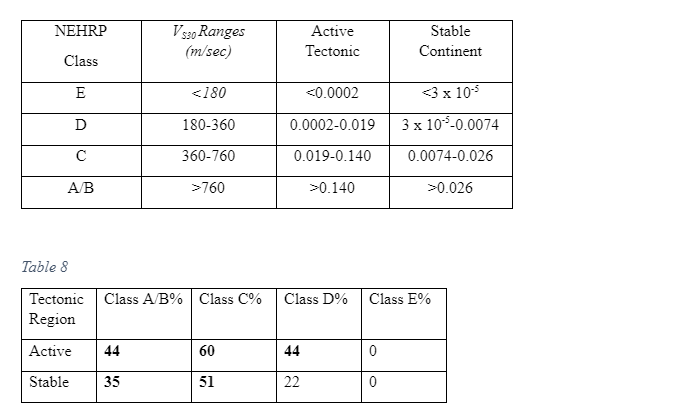
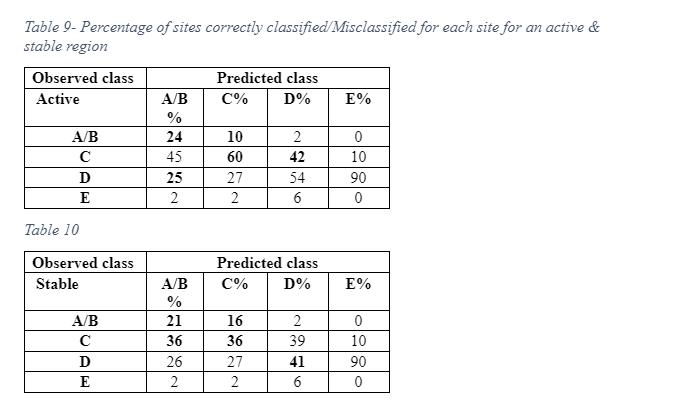


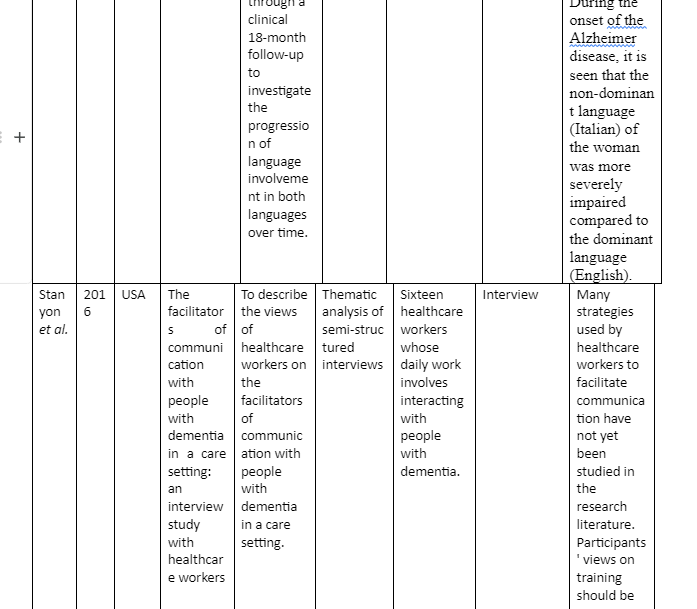
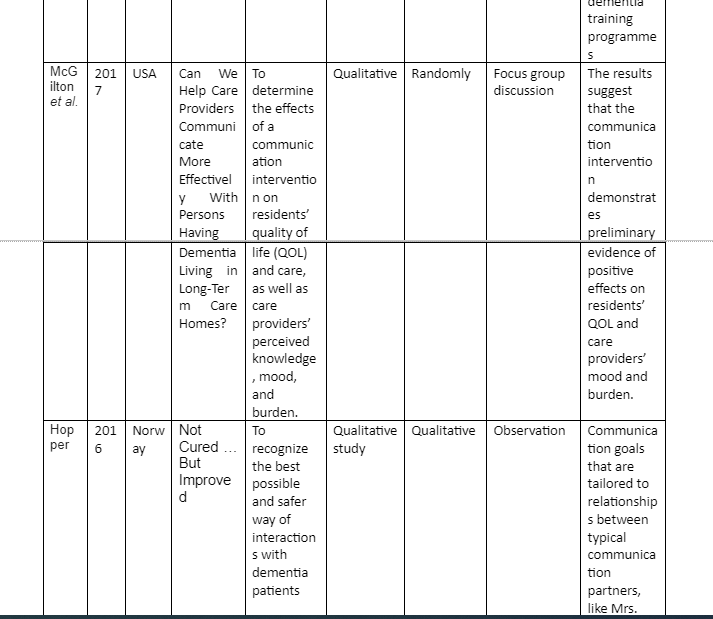
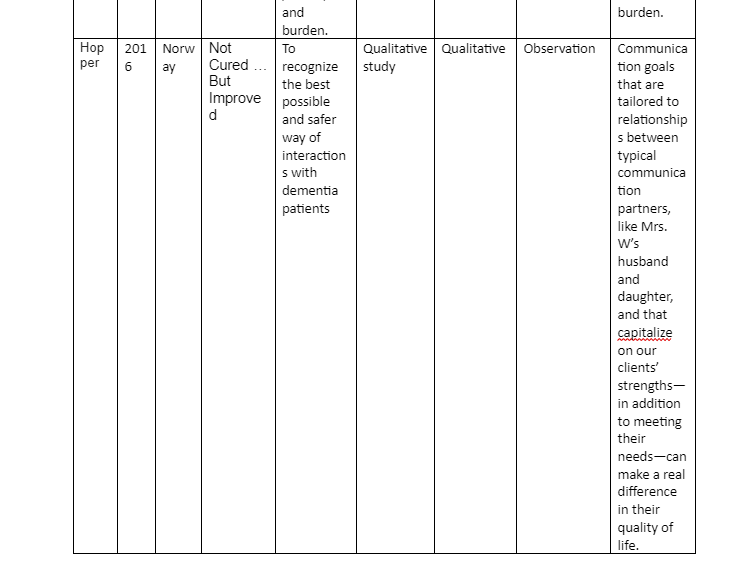
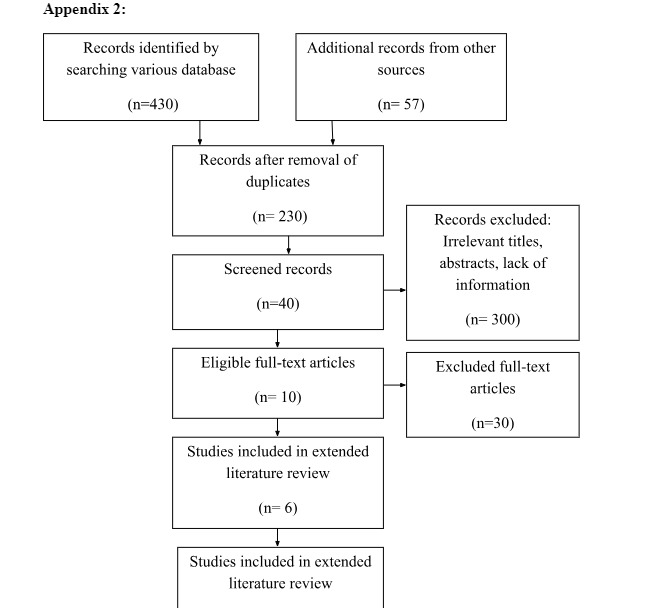
Looking for further insights on Navigating the Challenges of Autism Care? Click here.
- 24/7 Customer Support
- 100% Customer Satisfaction
- No Privacy Violation
- Quick Services
- Subject Experts



